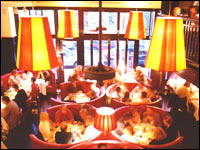|
In the end, Tom and Abigail decided not to buy in the West Eighties or Nineties. Instead, they found more space for their money and a home for their five cats and Tom's collection of Arts and Crafts furniture much farther uptown at 157th and Riverside, where they have easy access to the George Washington Bridge. Because even when they don't go upstate, Tom likes to go out for a drive just to clear his head.
|
|
| In Ouest :
The bistro's red leather booths and banquettes. |
The apartment, a rambling three-bedroom with walls painted rich, deep grays, greens, and browns, like the restaurant 70 blocks south, has grounded Valenti and given him ballast. He built the kitchen himself; but he harbors no fantasies about cooking elaborate meals there. The wood-paneled dining room with its divided glass doors houses not a grand table — "When am I going to cook for twelve at home?" he asks — but a Mission-style pool table he found in an antiques store in Syracuse.
For all that, fly-fishing remains the organizing theme in his life. Surprisingly, for a chef, Valenti doesn't keep his catch. Nor does Abigail, herself an accomplished fly-caster who would just as soon leave the hooks off. In the end, it's about respite from the world. "I quickly go to zero," he says, "when I get into a stream with the water rushing around my legs."
"Cooking for me was always about getting up early and getting moving and organized," Valenti says. "I get to commune with my products, pay attention to the curing and the smoking, before my staff shows up and kicks me out." Much of the flavor in his densely but delicately layered dishes is added long before the final cooking is done during dinner service. That's the only way to create signature dishes like braised lamb shanks with a rich caramelized sweetness that hovers over the humble peasant protein, or silky gravlax resting on a chickpea pancake spiked with unctuous caviar and a spicy mustard oil.
Through his clever pairings, Valenti has elevated earthy, slow-cooked food to an art form, some secrets of which are revealed in his first cookbook, which appears this month from HarperCollins. "I should change the menu," Valenti says with the tone of a father indulging a long-wished-for child. "It's time. But some of the dishes are still getting press.
"I think that if you can capture something from someone's childhood," the chef says in describing the sense memory he aims to evoke with his food, "people really identify with that." Like some secret ingredient, the customer's own sepia-toned culinary touchstones seem to be an integral part of the experience. Take a menu standout like smoked sturgeon served with a poached egg and lardon. How many of his patrons tuck into that appetizer while thoughts of an idealized country breakfast flit subliminally across their palates?
Valenti's own culinary memories were first formed in Ithaca, New York, where he was raised by a single mother who sent him to his grandparents' house after school while she worked as a legal secretary. As his grandparents baby-sat, Valenti soaked up their traditions: a kitchen garden, secret sauce recipes, and homemade wine. It wasn't until years later, though, after a stint learning basic skills at Ithaca's sole purveyor of French cuisine, that he got his real training.
Moving to Westchester in 1980, Valenti stumbled upon an ad for a personal chef. At the interview, the guy asked, "Have you eaten at Lutèce?" Valenti had never heard of it. He asked, "Do you shop at Dean & Deluca?"
"I didn't know what he was talking about," Valenti remembers. "But we got to talking about food." And the next thing Valenti knew, he was cooking on the Westchester estate of a private investor with the bizarre proviso that he not repeat any dish for at least 200 meals. (And you thought Iron Chef was implausible.)
From there, Valenti drifted into a job in Greenwich, Connecticut, at a branch restaurant of famed French chef Guy Savoy, which led to a stint at the Paris mother ship. "It was frightening not speaking the language," Valenti remembers, even though Savoy put him up until he got his bearings and found a tiny apartment. "If you didn't close the door, you walked right into the shower. You couldn't get up the stairs if you'd had a big meal."
At the Charles de Gaulle airport, on the way home after fifteen months, Valenti ran into Daniel Johnnes, now the sommelier at Montrachet but then just a cocky aspiring cook. Johnnes introduced Valenti to another friend on the same flight back to New York, Alfred Portale, who'd just come from his own year of training with Michel Guerard. The three Americans compared notes. Not long after, Portale invited Valenti to be his sous-chef at Gotham Bar and Grill.
"I left nothing up to anyone's individual interpretation," Portale remembers of the difficulty he and Valenti had in taking labor-intensive French food and remaking it for a New York kitchen. "There were no squiggles, there were no free-forms. It was all very precise." It had to be. Portale, a former jewelry designer, shocked customers by literally raising food on the plate in architectural designs that soon transformed American eating.
|
